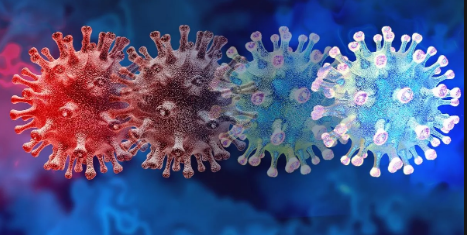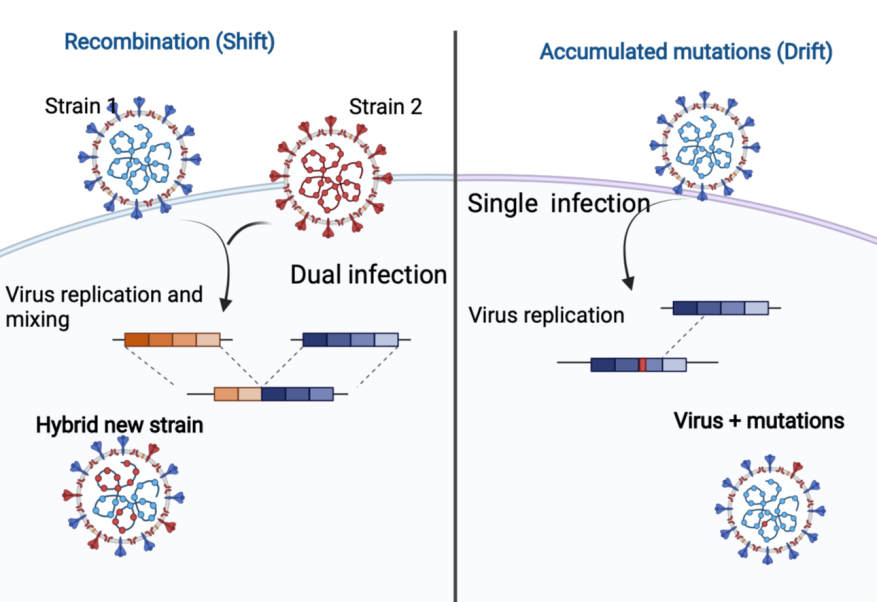Description

Copyright infringement not intended.
Context
- The World Health Organization (WHO) has flagged the emergence of a new variant of the SARS-CoV-2 virus — the XE recombinant.
What are variants of SARS-COV-2?
- It is normal for viruses to change and evolve as they spread between people over time.
- When these changes become significantly different from the original virus, they are known as “variants.”
- To identify variants, scientists map the genetic material of viruses (known as sequencing) and then look for differences between them to see if they have changed.
- Since the SARS-CoV-2 virus, the virus that causes COVID-19, has been spreading globally, variants have emerged and been identified in many countries around the world.
Difference between Variant and Mutation
- Viruses are constantly evolving and changing. Every time a virus replicates (makes copies of itself), there is the potential for there to be changes in its structure. Each of these changes is a “mutation.” A virus with one or more mutations is called a “variant” of the original virus.
- Some mutations can lead to changes in important characteristics of the virus, including characteristics that affect its ability to spread and/or its ability to cause more severe illness and death.
Mutation and SARS-Cov-2
- A mutation is a change in a genetic code.
- Mutations can result from DNA/RNA copying mistakes made during replication of repeating elements.
- Each SARS-CoV-2 includes approximately 30,000 letters of RNA. This genetic data enables the virus to attack cells and hijack them to replicate.
- Small copying mistakes called mutations are made when an infected cell builds new corona-viruses.
Notable variants of SARS-CoV-2
- A set of coronaviruses that share the identical inherited set of distinct mutations is referred to as a variant.
- There are lineages or clades or subtypes.
- Earlier, there was the ancestral type — the Wuhan virus type, from which 10 lineages had evolved.
- A lineage is given a name if its frequency reaches 20% globally.
- Further, an evolved lineage is given a separate identity if it differs from the existing lineages by at least two DNA changes (mutations).
- Based on the revised time-stamped nomenclature, there are now five lineages: 19A, 19B, 20A, 20B and 20C.
- The first two digits reflect the year in which the lineage evolved.
- 1.7 Lineage, B.1.351 Lineage, P1 Lineage
- D614G: It is a mutation that alters the spike protein of the SARS-CoV-2 virus.
- E484K: E484K is described to be an “escape mutation” because it helps the virus slip past the body’s immune defence mechanism. The recent Bengal Strain has been formed by E484K mutation.
About XE variant
- XE is known as a recombinant, meaning it is essentially a mixture of two different viruses or variants with characteristics of both. Specifically, XE is a mixture of the two Omicron variant sub-types BA.1 and BA.2.
- Recombination occurs when coinfecting viruses exchange genetic information, creating a novel virus.

Copyright infringement not intended.
- Recombinants occur when a person is infected with two different viruses, such as variants of COVID, at the same time, causing the viruses to mix when they replicate.
- XE is among three recombinants to have been named by researchers recently, with the others being XD and XF.
- The latter two are mixtures of Omicron and Delta which do not appear to have spread as much as XE.
- XE and XF have been found in the U.K., while XD has been found in other countries in Europe.
- 3 new recombinants have been designated (see @PeacockFlu thread below)
- XD: Delta x BA.1 (mostly in France but also Denmark, Belgium. None in UK.)
- XE: BA.1 x BA.2 (UK only)
- XF: Delta x BA.1 (UK only)
- Omicron has been reported to be the dominant strain worldwide with 99.7 per cent of the fresh samples belonging to the variant, according to the WHO.
- (WHO) noted that XE may have a growth advantage of 10 percent over the currently dominant BA.2 Omicron sub-variant, meaning it could spread slightly faster.
- One concern about recombinants is that they could potentially (but not necessarily) combine features of two variants to make a mixture that is more dangerous than both of them individually.
Read: https://www.iasgyan.in/blogs/bengal-strain-all-about-mutation
https://www.iasgyan.in/daily-current-affairs/ihu-variant-of-covid-19
https://www.iasgyan.in/daily-current-affairs/mu-variant
https://www.hindustantimes.com/world-news/what-is-a-recombinant-variant-5-things-who-said-amid-fears-over-new-xe-strain-101648953284213.html
















